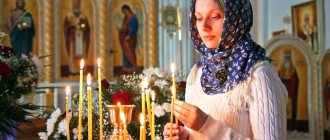Orthodox Life
Answered by priest Andrei Chizhenko.
An attempt to answer this seemingly simple question leads us to one of the main qualities of the Church - She is not of this world. Its task is to lead man, and with him the entire created world, to salvation, to the higher - spiritual Heaven. Hence the color of the clothes of the servants of the Church - priests and monks. He is basically black, with a few exceptions. Let me make a reservation that in this article we are not talking about the colors of liturgical vestments, which already have the color symbolism of the holiday in the liturgical sense. Here we are talking rather about the everyday clothing of a clergyman and a monastic - a cassock and cassock. The Greek word ράσον is translated into Russian as worn-out, worn-out clothing. Monks of antiquity wore such clothes; later it became the everyday clothing of clergy. The second such clothing is the cassock; accordingly, according to the meaning of the word, it is worn under the cassock.
The black color of the cassock and cassock symbolizes precisely this otherworldliness of the Church, that desire for salvation, for our Heavenly Father, to Whom, in essence, the shepherd of Christ’s verbal sheep must lead. Therefore, the unusualness of priestly clothing is also a silent sermon. And a person who sees a priest or monk on the street will still think about the eternal, think about God. The black color of the cassock has a dual meaning.
First, of course, is death. Dying to the world. Both the priest and the monk are those people who voluntarily sacrificed themselves to God in order to become His servants. Both the priest and the monk (each in his vows: there are monastic vows, there is a priestly oath) renounce the world and recognize God as the Center of their life. They are buried with Christ, as if dying for the world, in order to enter eternal life and become guides into it for other people.
Secondly, the black color of priestly robes is still, as it were, the absence of color, going beyond the boundaries of earthly existence, into the supermundane Divine peace.
When you, a clergyman, put on a cassock, it disciplines you, the realization comes that you are a warrior and servant of Christ; that through the Liturgy and other Sacraments you yourself enter into the invisible Heaven and lead people there, becoming an intercessor before God for the people.
Righteous John of Kronstadt writes about this in his diary entries: “It is sinful for a priest to pray only for himself. “Prayer for the flock should follow him everywhere.”
Therefore, we see that everything in the Church is harmonious and harmonious. And there are no random details, even the smallest ones, including the black color of the cassock. Everything calls a person to Heaven.
After all, everything is not just like that. The merciful Lord has His kind and fatherly care for everyone. And when you see a priest in a cassock in a bustling and hurrying city, he reminds you with all his appearance that everyone needs to find their way to the Church, enter Her, stand in prayer and, opening the door to the temple, step into Heaven.
The difference between a burqa and a hijab
Hijab in the classical sense means an opaque, spacious robe that hides the entire body of a woman with the exception of the hands and the oval of the face. It does not have a specific appearance; any clothing that combines the above requirements can be called a hijab.
Particular attention is paid to the headscarf that Muslim women use to cover their heads, shoulders, hair and neck.
The burqa, unlike the hijab, completely hides a woman’s face from prying eyes. Even the eyes are covered with mesh fabric. Shariah norms do not dictate rules for women to wear a burqa.
Initially, this attribute of clothing served to protect the believing population from the evil eye, and did not have a specific gender.
Interesting! 5 most interesting facts about the Caucasus
The hijab, on the contrary, is an integral part of the women's wardrobe in Muslim countries. Islam prohibits girls and women from openly demonstrating their beauty. But this does not mean that the weaker sex is obliged to wear closed clothes around the clock.
If a woman is alone with her husband or friends, she has the right to wear any clothes, including those that openly demonstrate all parts of the female body.
The presence or absence of the right to show one’s face to others depends primarily on the charter of the family in which the girl grew up. Most women brought up in the strict norms of Islam, of their own free will, decide to hide their faces. The fact is that the female population of Muslim countries treats their spouses with special respect and trepidation. Therefore, the right to contemplate the beauty of a wife is granted only to the legal husband.
Arab women: education and career
Shopping and household chores are not the meaning of existence for Arab women. They engage in self-development, study and work.
In progressive countries such as the UAE, women receive a good education. After school, many enter universities created specifically for them, and then get a job. Moreover, women are engaged in the type of activity that they really like. They work in education, in the police, hold important positions in government departments, and some have their own businesses.
Another country where Arab women can realize themselves is Algeria. There, many representatives of the fair sex find themselves in law, science, and also in the healthcare sector. There are more women working as judges and lawyers in Algeria than men.
Interesting Facts
In accordance with the norms, the burqa must be made of black fabric. There are no such strict requirements for the hijab
The only rule is the absence of overly bright fabrics that can attract undue attention to a woman.
For religious women, wearing the hijab is mandatory after reaching adulthood. In Islam, a girl becomes an adult from the moment she begins menstruation.
In Turkmenistan, Tajikistan, Uzbekistan, Kazakhstan and Azerbaijan, women are prohibited from appearing in hijab in educational and government institutions. Until recently, Turkey was one of these countries, but in 2005 the state authorities lifted this ban, considering that such a requirement violated the rights of the female population.
Gurta - scarf of Arab men
The appearance of Arab men is inseparably linked with the headscarf. But under it they also wear a cap (gafia), usually white. The headscarf is called a gurta and its wearing is also historically associated with the Bedouin way of life. The fabric protected the entire head, as well as the neck, from sandstorms and the heat of the sun. In modern life, which mostly takes place in cool rooms under air conditioning, the gurta has lost its former role and is worn as a tribute to tradition.
The gurta is worn in two ways. The first, which occurs most often, involves hanging the ends of the scarf along the body. According to the second method, the edges of the edge are thrown over the head, while no hairpins or pins are used to hold it. Arabs who have practiced wearing the gurta since childhood have the appropriate skill and experience for this.
The head scarf of Arab men is often held together by a black woven ring called an igal.
Igal also has a history from the past. Bedouins tied camels' legs with it during overnight stays, and also used it as a whip. And so that the rope was at hand the rest of the time, they tied it around the head.
Today, the igal has been preserved only as a decorative part of the national headdress of the Arabs; it also helps to hold the edge so that it does not blow away in the wind.
Did you like the material? Please tell others about this, repost it on social networks!
Facial care
To cleanse the skin of the face, oriental beauties use a natural tonic - rose water. It can easily replace micellar water. The product has a calming effect, relieves inflammation and redness of the skin.
While European girls strive for a golden tan at any time of the year, oriental beauties, on the contrary, try to whiten their skin. For this they use a natural bleach - citric acid. If you want fresh and glowing skin, wipe your face with lemon juice. And one more beauty trick from oriental beauties: the soft side of a lemon peel can be an excellent scrub.
As you probably already guessed, Arab girls also prefer natural face masks. The most popular ingredient in “homemade masks” is turmeric. Making such a mask yourself is easy and simple: mix 2 tbsp. flour, a pinch of turmeric, 2 tbsp. rose water and the same amount of milk. Apply the resulting paste to your face, hold for 20 minutes and rinse with warm water.
Is polygamy a problem?
Residents of Europe are horrified not only by the issue of violence, but also by polygamy, which is officially permitted in all Arab countries. How can a woman tolerate such chaos?
In reality, this problem practically does not exist. To marry another girl, you must obtain the consent of your current wife. Not every Arab woman, even taking into account her upbringing, will agree with this state of affairs.
In principle, men rarely take advantage of their privilege to have several wives. It's too expensive. After all, the living conditions for all wives should be the same. If this rule is not followed, then the wife, whom her husband infringes financially, can file for divorce, and the trial will end in her victory.
Body care
What is oriental culture without a hammam! Wet baths (also known as Turkish baths) are very beneficial for health, and therefore oriental beauties do not deny themselves the pleasure of steaming in the hammam. Thanks to this, all excess dirt is removed from the body through the pores, and the skin becomes smooth and velvety. In addition, oriental beauties always take natural body scrubs with them to the bathhouse. The most popular recipe is a scrub made from coffee grounds. You can use pure coffee grounds or mix them with shower gel. You will see, after the first procedure your skin will become soft and perfectly smooth.
Social role of women in Islam
Everyone who lives in Arab countries adheres to Islam. A woman observes Ramadan and performs prayers just like a man. Socially, a woman is the keeper of the hearth, who is involved in raising children. She must respect her husband, who is obliged to fully provide for his wife and be responsible for her.
The woman, in turn, is obliged to obey her husband, and to do so unconditionally. She must be submissive and modest. They begin to accustom her to the role of wife and housewife from childhood.
Of course, a woman’s life is not limited only to activities at home. She can work and study, but only if these activities do not interfere with her family happiness.











